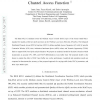Free Online Productivity Tools
i2Speak
i2Symbol
i2OCR
iTex2Img
iWeb2Print
iWeb2Shot
i2Type
iPdf2Split
iPdf2Merge
i2Bopomofo
i2Arabic
i2Style
i2Image
i2PDF
iLatex2Rtf
Sci2ools
125
click to vote
CORR
2007
Springer
2007
Springer
Analysis of the 802.11e Enhanced Distributed Channel Access Function
The IEEE 802.11e standard revises the Medium Access Control (MAC) layer of the former IEEE 802.11 standard for Quality-of-Service (QoS) provision in the Wireless Local Area Networks (WLANs). The Enhanced Distributed Channel Access (EDCA) function of 802.11e defines multiple Access Categories (AC) with AC-specific Contention Window (CW) sizes, Arbitration Interframe Space (AIFS) values, and Transmit Opportunity (TXOP) limits to support MAC-level QoS and prioritization. We propose an analytical model for the EDCA function which incorporates an accurate CW, AIFS, and TXOP differentiation at any traffic load. The proposed model is also shown to capture the effect of MAC layer buffer size on the performance. Analytical and simulation results are compared to demonstrate the accuracy of the proposed approach for varying traffic loads, EDCA parameters, and MAC layer buffer space.
Related Content
| Added | 25 Dec 2010 |
| Updated | 25 Dec 2010 |
| Type | Journal |
| Year | 2007 |
| Where | CORR |
| Authors | Inanc Inan, Feyza Keceli, Ender Ayanoglu |
Comments (0)

